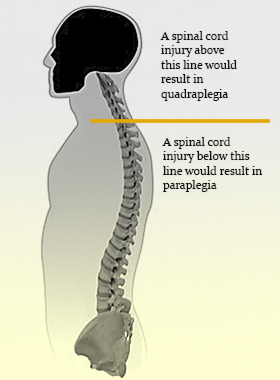Paralysis occurs following damage to the central or peripheral nervous system that interferes with the communication between the motor cortex and your limbs and torso. This results in a lack of control (though this is not always required to be total loss of movement to count as ‘paralysis’) and normally a change in muscle tone and often a loss of sensation.
Paralysis is most often a result of stroke or spinal trauma due to the fact that all of the signals in the human body travel through nerves located in the spine. Meanwhile injury to the arm or other brain areas might result in monoplegia (see below), while a disease such as multiple sclerosis can also cause varying degrees of paralysis by damaging the nerve cells.
 While many people are familiar with the concept of paralysis and the various causes, most are also unaware of the different classifications and what they mean. In all cases paralysis is caused by the inability for signals to travel normally up and down the spine and to relay information to and from the brain. This then blocks sensory signals – which are those that come from the body in to the brain; as well as motor signals – which are the signals from the brain to move the limbs.
While many people are familiar with the concept of paralysis and the various causes, most are also unaware of the different classifications and what they mean. In all cases paralysis is caused by the inability for signals to travel normally up and down the spine and to relay information to and from the brain. This then blocks sensory signals – which are those that come from the body in to the brain; as well as motor signals – which are the signals from the brain to move the limbs.
The different forms of paralysis are caused as a result of the injury being located in different places around the spine and so affecting different parts of the body.
The Different Types of Paralysis
Quadraplegia: Quadraplegia is paralysis affecting all four limbs and the trunk and this is a result of a spinal injury occurring above the thoracic vertebra. This might also result in tetraplegia, which is loss of movement and sensation in three of the limbs.
Paraplegia: Paraplegia is paralysis caused by injury located below the thoracic vertebra, resulting in loss of movement in both legs. When you see someone in a wheel chair due to spine injury this is most often the form of paralysis they are suffering.
Monoplegia: Monoplegia is paralysis caused by spinal injury that affects just one of the limbs and is usually a result of damage to localized areas of the peripheral nervous system, or the corresponding parts of the motor cortex.
Diplegia: Diplegia affects to symmetrical parts of the body, normally both of the arms or two sides of the face.
Hemiplegia: Hemiplegia affects only one side of the body resulting in loss of movement down one side. This is commonly a result of stroke affecting one of the hemispheres in the brain – though interestingly the paralysis normally occurs on the opposite side of the brain to the side that was damaged.



